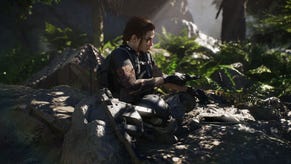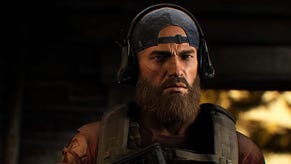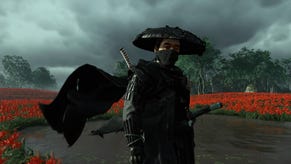Lone wolf begone: three-for-all with Ghost Recon Online
As the beta rumbles steadily forward to a full release, Stace Harman looks at how Ghost Recon Online’s numbers stack up.
Three: it’s the magic number; it’s the denomination in which bad news arrives; it’s the number of the classes available to play in Ubisoft’s free-to-play, third-person, cover-based shooter, Ghost Recon Online. So, what is the number three for Ubisoft: triumphantly potent or worryingly portentous?
Approaching Ghost Recon Online, I’m immediately dubious of the seemingly slender pickings that it offers: four maps, three character classes and two game modes, which brand manager Pierre Thomas suggests is representative of the content that will be initially available when the game emerges from beta later this year.
Countering this dearth of map and game mode choices is Ghost Recon Online’s most immediate strengths, which are drawn from the wider franchise: just five minutes in, it’s evident that the route-one approach of running and gunning is going to result in nothing but a quick death and the minor prickle of frustration.
Instead, Ghost Recon Online is deliberately positioning itself as a more considered free-to-play offering; one that promotes and rewards investment, specialisation and, above all, the key tenets of the Ghost Recon franchise: team work and the strategic use of future tech.
“It's really a tactical team-based shooter and so you don't play a lone wolf,” explains community manager Juan Eduardo Eguiguren when I relay to him my embarrassing raft of early deaths. “You're very much part of a team; being a very good player and going it alone just isn't enough.”
“You're playing in the near future with key technology and devices,” adds Thomas. “If you compare it to the classic Ghost Recon games you'll find the same spirit runs through Ghost Recon Online and so you can't win a game without using your strategic abilities.”
It’s these strategic abilities that form the basis of the customisation options of Ghost Recon Online and bolster that seemingly meagre offering of three classes, to allow for focused specialism. The abilities come in two distinct flavours: active powers, dubbed ‘devices’, and passive, team-based buffs. Both devices and team abilities are class specific, with a choice of two of each type for the three character classes: Recon, Specialist and Assault.
The team-based abilities come into play after progress has been made through several levels and open up useful but unspectacular buffs, such as providing ammo to team mates or boosting defence, but it’s through use of the devices that matches are won or lost. Choosing when to deploy devices – and which to use in conjunction with one another – is what adds the layer of strategy and elevates Ghost Recon Online above simple run-and-gun antics that rely on the endless cycle of spawn-spam-die-repeat.
The Specialist, for example, has the ability to deploy the Aegis shield to provide cover for a handful of team mates to push through choke points by rendering those inside its sphere invulnerable to bullets, for a limited time. However, this is can be countered by the second device of the very same class: an EMP generator that disrupts all devices in a limited radius.
The Recon’s franchise-familiar cloaking technology provides the perfect camouflage to move into a strategic sniping position, but the Recon also has access to Oracle, which transmits red outlines of all enemy troops, whether behind cover or cloaked, to the HUD of every friendly team member.
Finally, the Assault class’ subtle-as-a-sledgehammer Blitz endows it with a riot shield and offers a speed and power boost that allows for charge manoeuvres into heavily defended territory but is weak against an opposing Assault’s HEAT device that uses microwave technology to fry fools who rush in.
It’s through these delicately balanced pairings of attack and counter-attack, and the fact that only one active and passive power can be selected per class, that Ghost Recon Online finds its ebb and flow and promotes mini-battles against opposing team members of the same class. That’s not to say that each class can only be countered by its mirror, of course, as there’s nothing to stop an Assault character Blitzing an AEGIS-touting Specialist whose shield is effective against incoming munitions but not blunt trauma to the head. Similarly, a Specialist that deploys Blackout in a known sniper location is likely to find at least one camped, cloaked Recon who suddenly looks very silly; lying there prone, sheepish and soon to be dead.
Show me the money
So, at what point do you have to cough-up the cash or risk getting left behind? Well, real-world cash can be used to purchase in-game currency, which in turn can be spent on weapon and armour unlocks. But a separate in-game currency earned, in varying amounts, by winning or losing rounds and by participating in the daily challenges, can be used for the same purpose.
Ultimately, Ghost Recon Online does an admirable job of convincing you that it’s not a free-to-play game at all but, curiously, that’s its biggest strength and greatest weakness. The visuals, game design and balancing emulate a full-priced offering, but it’s less than generous map pack suggests micro-transaction where currently there are none.
Nor is it currently the most forgiving or inviting title for new players, who might be expecting the free-to-play moniker to equate to large helpings of positive reinforcement and being showered in free items and upgrade options early on, neither of which materialise.
As the beta stands, it refuses to cater to run-and-gun junkies who want a five-minute free-to-play fix. By doing so, Ghost Recon Online positions itself to reward a longer-term investment of time, regardless of whether you ever decide to fork out any money. Furthermore, players that revel in team-based games, especially those that buddy-up with friends to form tight knit squads, are going to revel in the satisfaction that being on a team in which everyone knows their chosen class inside-out can bring.
Ubisoft will need to sustain the community with regular, well considered content delivery in the form of new maps and game modes, but the seemingly miserly decision to offer just three character classes reveals itself to be a major boon. Through judicious distribution of class-specific devices, Ghost Recon Online promotes specialism to elicit the feeling of playing an active and useful role in a team. Assuming it doesn’t disrupt this balance with future updates, this magic triumvirate could prove Ghost Recon Online’s most unique and appealing feature going forward.
Ghost Recon Online is expected to launch later this year for PC. A Wii U version is also in development.













